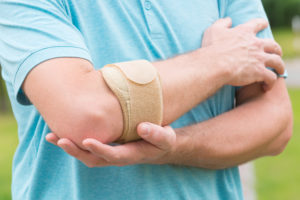 Tennis elbow sounds like a condition that should only affect the Serena and Venus Williamses of the world, but it’s actually a common condition that could impact you even if you don’t play a sport. If you’ve been dealing with elbow pain, make sure you know the signs and symptoms of tennis elbow so you can seek the best treatment.
Tennis elbow sounds like a condition that should only affect the Serena and Venus Williamses of the world, but it’s actually a common condition that could impact you even if you don’t play a sport. If you’ve been dealing with elbow pain, make sure you know the signs and symptoms of tennis elbow so you can seek the best treatment.
The Basics of Tennis Elbow
Tennis elbow is also known as lateral epicondylitis. It is a very painful condition that occurs when the elbow has been overused. Though it’s most prevalent among tennis players and other racquet sport players who rely on elbow movements every day, non-athletes are vulnerable as well.
When the elbow repeats the same motions over and over again, the tendons that join the forearm muscles on the outer part of the elbow become inflamed, and inflammation leads to pain and tenderness in that area. If you perform activities at work or through another hobby that require this type of movement, tennis elbow could be the result.
Common Causes and Symptoms of Tennis Elbow
Other than playing tennis and other racquet sports, tennis elbow is likely to occur in painters, plumbers, and carpenters, as well as auto workers, cooks, and possibly butchers due to the repetitive arm motions involved in their jobs. Ages 30 to 50 witness the most occurrences of tennis elbow, though it can be found in a person of any age.
It is pretty easy to identify tennis elbow, since the elbow is rarely a painful part of the body otherwise. When the outer section of the elbow begins to burn or experience pain, combined potentially with weaker grip strength, tennis elbow is the most likely culprit. Most people are only impacted by tennis elbow in their dominant arm since it is used more.
How to Treat Your Tennis Elbow
Fortunately, despite the pain it causes, tennis elbow has readily available treatments, and full recovery is possible. Up to 95 percent of patients are successfully using nonsurgical treatments like rest, anti-inflammatory medicine, physical therapy, and an elbow brace. Surgery is an option for severe cases, but you can also avoid surgery by opting for a new and innovative stem cell and PRP therapy.
The team at Regenerative Orthopedic Institute offers cutting edge stem cell and PRP treatments like RegenaJoint to provide relief for ongoing pain. Call (813) 359-0962 today to learn more about RegenaJoint and the non-surgical options to feel comfortable once again.
